人教版(2019)必修 第三册Unit 1 Festivals and CelebrationsReading for Writing 教学设计(表格式)
文档属性
| 名称 | 人教版(2019)必修 第三册Unit 1 Festivals and CelebrationsReading for Writing 教学设计(表格式) | 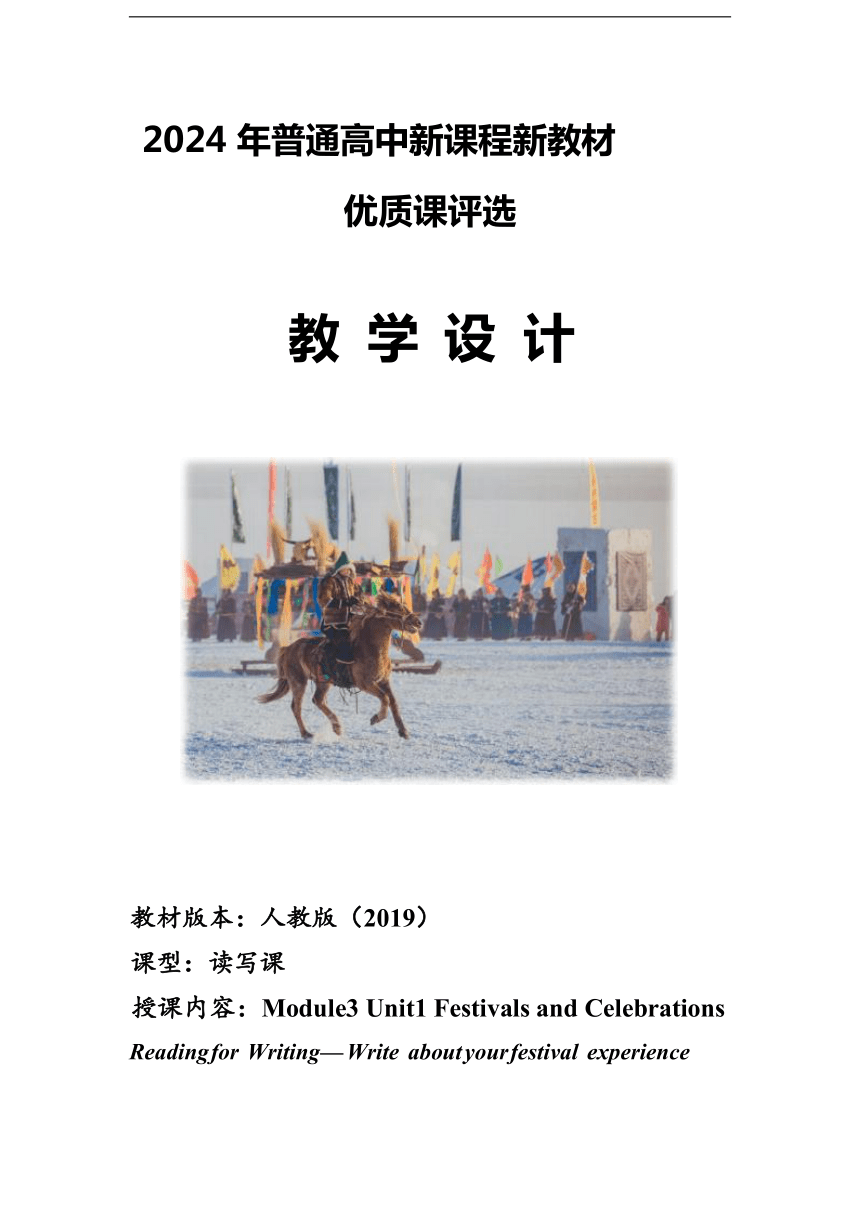 | |
| 格式 | docx | ||
| 文件大小 | 432.9KB | ||
| 资源类型 | 教案 | ||
| 版本资源 | 人教版(2019) | ||
| 科目 | 英语 | ||
| 更新时间 | 2024-03-02 10:55:52 | ||
图片预览

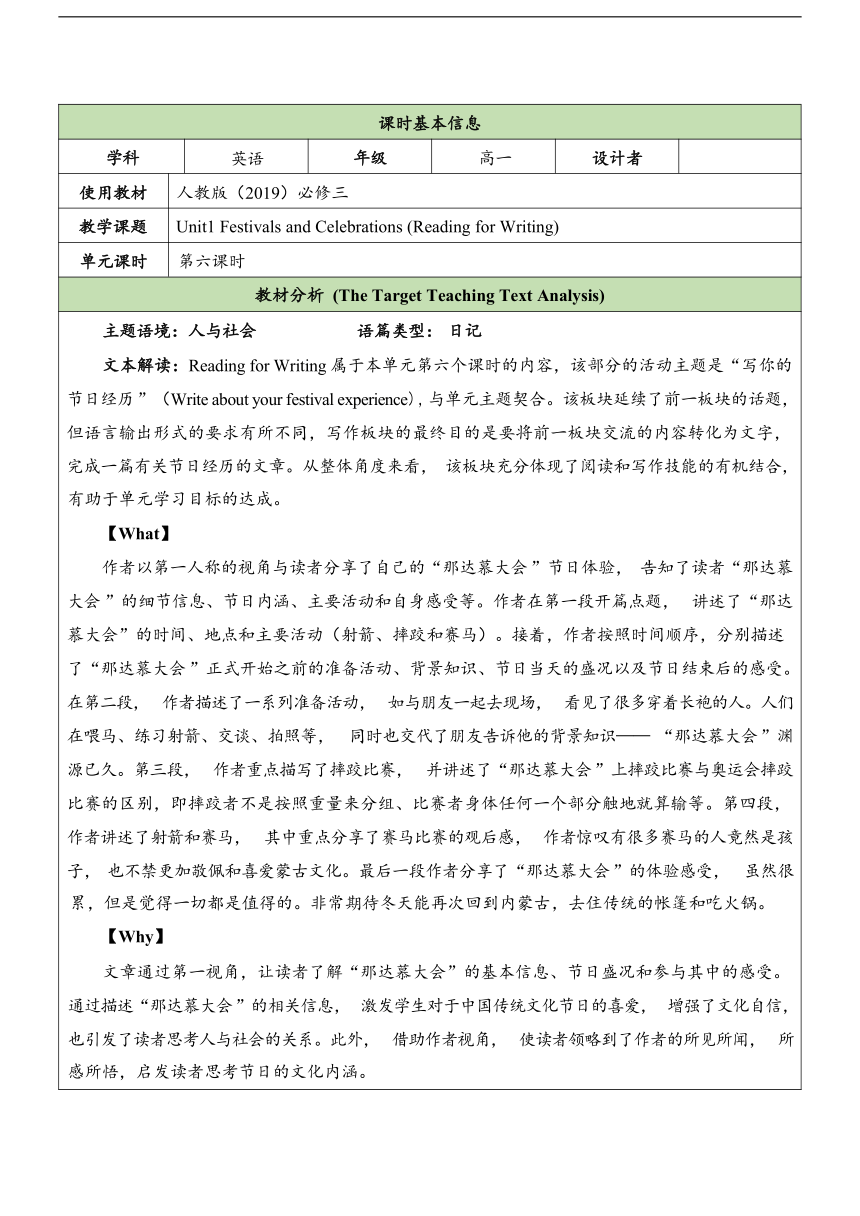
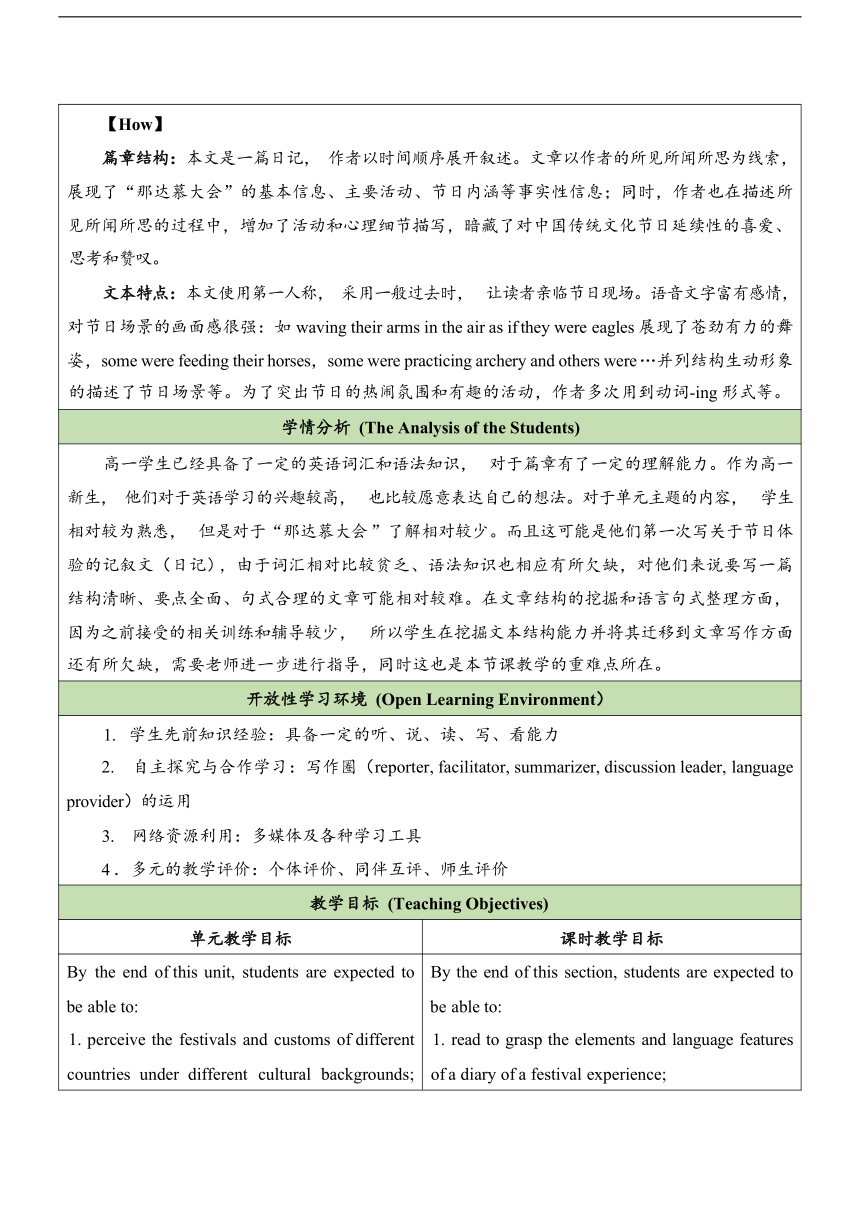
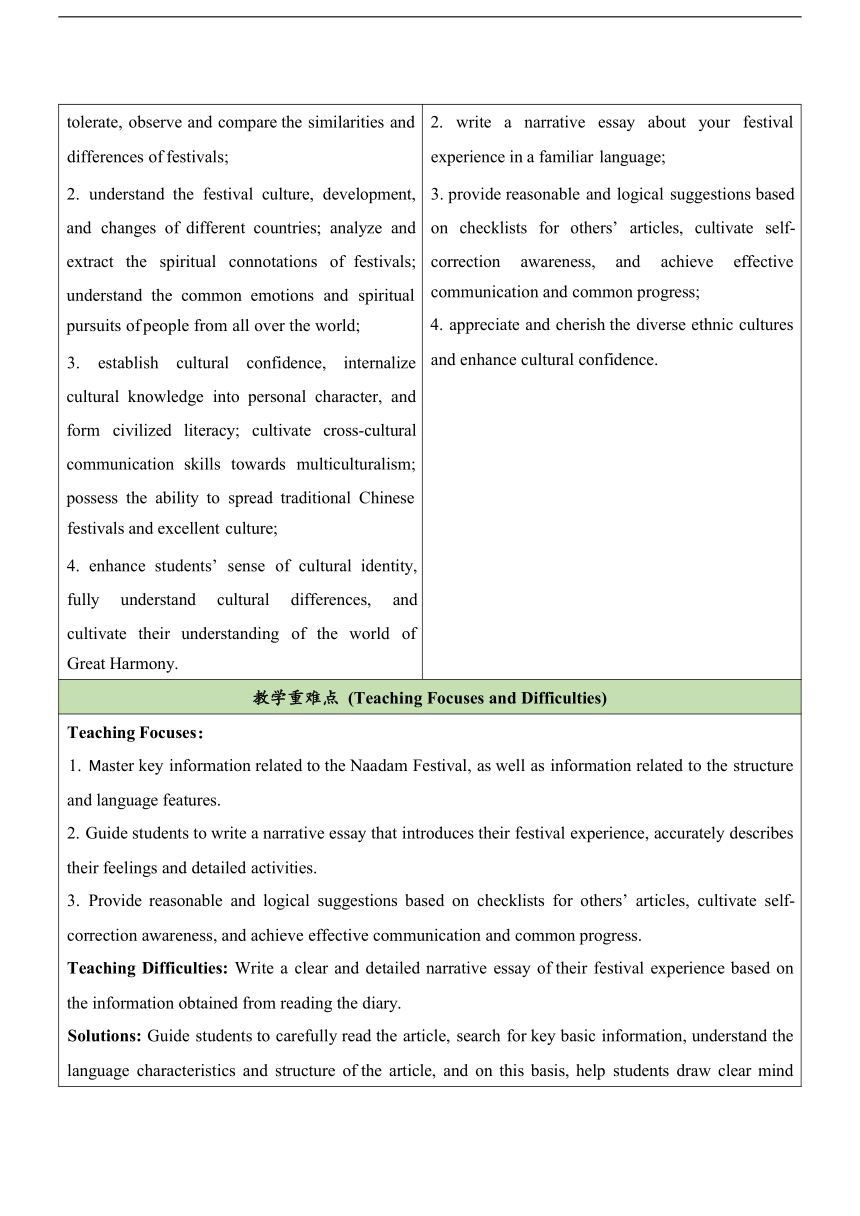
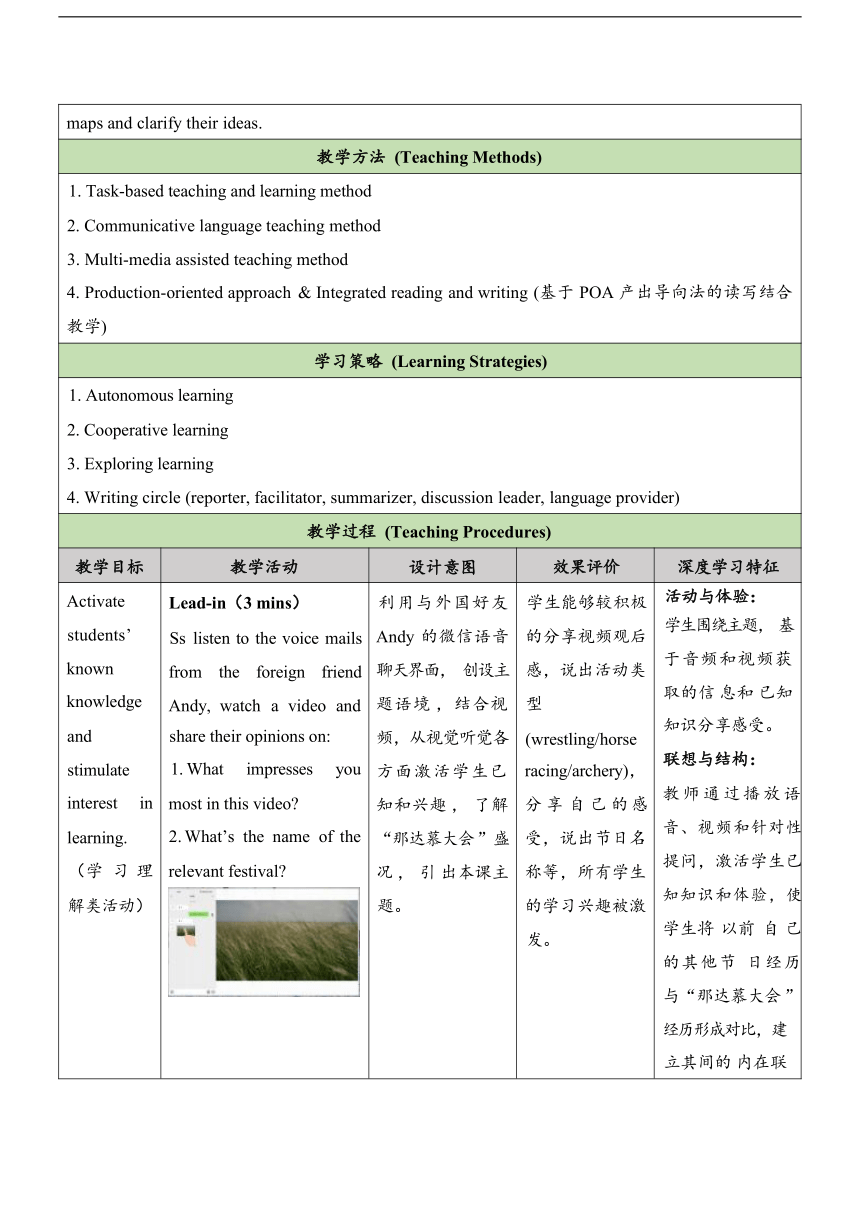
文档简介
2024 年普通高中新课程新教材
优质课评选
教 学 设 计
教材版本:人教版(2019)
课型:读写课
授课内容:Module3 Unit1 Festivals and Celebrations
Reading for Writing—Write about your festival experience
课时基本信息
学科 英语 年级 高一 设计者
使用教材 人教版(2019)必修三
教学课题 Unit1 Festivals and Celebrations (Reading for Writing)
单元课时 第六课时
教材分析 (The Target Teaching Text Analysis)
主题语境:人与社会 语篇类型: 日记 文本解读:Reading for Writing 属于本单元第六个课时的内容,该部分的活动主题是“写你的 节日经历 ”(Write about your festival experience),与单元主题契合。该板块延续了前一板块的话题, 但语言输出形式的要求有所不同,写作板块的最终目的是要将前一板块交流的内容转化为文字, 完成一篇有关节日经历的文章。从整体角度来看, 该板块充分体现了阅读和写作技能的有机结合, 有助于单元学习目标的达成。 【What】 作者以第一人称的视角与读者分享了自己的“那达慕大会 ”节日体验, 告知了读者“那达慕 大会 ”的细节信息、节日内涵、主要活动和自身感受等。作者在第一段开篇点题, 讲述了“那达 慕大会”的时间、地点和主要活动(射箭、摔跤和赛马)。接着,作者按照时间顺序,分别描述 了“那达慕大会 ”正式开始之前的准备活动、背景知识、节日当天的盛况以及节日结束后的感受。 在第二段, 作者描述了一系列准备活动, 如与朋友一起去现场, 看见了很多穿着长袍的人。人们 在喂马、练习射箭、交谈、拍照等, 同时也交代了朋友告诉他的背景知识—— “那达慕大会 ”渊 源已久。第三段, 作者重点描写了摔跤比赛, 并讲述了“那达慕大会 ”上摔跤比赛与奥运会摔跤 比赛的区别,即摔跤者不是按照重量来分组、比赛者身体任何一个部分触地就算输等。第四段, 作者讲述了射箭和赛马, 其中重点分享了赛马比赛的观后感, 作者惊叹有很多赛马的人竟然是孩 子, 也不禁更加敬佩和喜爱蒙古文化。最后一段作者分享了“那达慕大会 ”的体验感受, 虽然很 累,但是觉得一切都是值得的。非常期待冬天能再次回到内蒙古,去住传统的帐篷和吃火锅。 【Why】 文章通过第一视角,让读者了解“那达慕大会”的基本信息、节日盛况和参与其中的感受。 通过描述“那达慕大会 ”的相关信息, 激发学生对于中国传统文化节日的喜爱, 增强了文化自信, 也引发了读者思考人与社会的关系。此外, 借助作者视角, 使读者领略到了作者的所见所闻, 所 感所悟,启发读者思考节日的文化内涵。
【How】 篇章结构:本文是一篇日记, 作者以时间顺序展开叙述。文章以作者的所见所闻所思为线索, 展现了“那达慕大会”的基本信息、主要活动、节日内涵等事实性信息;同时,作者也在描述所 见所闻所思的过程中,增加了活动和心理细节描写,暗藏了对中国传统文化节日延续性的喜爱、 思考和赞叹。 文本特点:本文使用第一人称, 采用一般过去时, 让读者亲临节日现场。语音文字富有感情, 对节日场景的画面感很强:如 waving their arms in the air as if they were eagles 展现了苍劲有力的舞 姿,some were feeding their horses,some were practicing archery and others were …并列结构生动形象 的描述了节日场景等。为了突出节日的热闹氛围和有趣的活动,作者多次用到动词-ing 形式等。
学情分析 (The Analysis of the Students)
高一学生已经具备了一定的英语词汇和语法知识, 对于篇章有了一定的理解能力。作为高一 新生, 他们对于英语学习的兴趣较高, 也比较愿意表达自己的想法。对于单元主题的内容, 学生 相对较为熟悉, 但是对于“那达慕大会 ”了解相对较少。而且这可能是他们第一次写关于节日体 验的记叙文(日记), 由于词汇相对比较贫乏、语法知识也相应有所欠缺,对他们来说要写一篇 结构清晰、要点全面、句式合理的文章可能相对较难。在文章结构的挖掘和语言句式整理方面, 因为之前接受的相关训练和辅导较少, 所以学生在挖掘文本结构能力并将其迁移到文章写作方面 还有所欠缺,需要老师进一步进行指导,同时这也是本节课教学的重难点所在。
开放性学习环境 (Open Learning Environment)
1. 学生先前知识经验:具备一定的听、说、读、写、看能力 2. 自主探究与合作学习:写作圈(reporter, facilitator, summarizer, discussion leader, language provider)的运用 3. 网络资源利用:多媒体及各种学习工具 4 .多元的教学评价:个体评价、同伴互评、师生评价
教学目标 (Teaching Objectives)
单元教学目标 课时教学目标
By the end of this unit, students are expected to be able to: 1. perceive the festivals and customs of different countries under different cultural backgrounds; By the end of this section, students are expected to be able to: 1. read to grasp the elements and language features of a diary of a festival experience;
tolerate, observe and compare the similarities and differences of festivals; 2. understand the festival culture, development, and changes of different countries; analyze and extract the spiritual connotations of festivals; understand the common emotions and spiritual pursuits of people from all over the world; 3. establish cultural confidence, internalize cultural knowledge into personal character, and form civilized literacy; cultivate cross-cultural communication skills towards multiculturalism; possess the ability to spread traditional Chinese festivals and excellent culture; 4. enhance students’ sense of cultural identity, fully understand cultural differences, and cultivate their understanding of the world of Great Harmony. 2. write a narrative essay about your festival experience in a familiar language; 3. provide reasonable and logical suggestions based on checklists for others’ articles, cultivate self- correction awareness, and achieve effective communication and common progress; 4. appreciate and cherish the diverse ethnic cultures and enhance cultural confidence.
教学重难点 (Teaching Focuses and Difficulties)
Teaching Focuses: 1. Master key information related to the Naadam Festival, as well as information related to the structure and language features. 2. Guide students to write a narrative essay that introduces their festival experience, accurately describes their feelings and detailed activities. 3. Provide reasonable and logical suggestions based on checklists for others’ articles, cultivate self- correction awareness, and achieve effective communication and common progress. Teaching Difficulties: Write a clear and detailed narrative essay of their festival experience based on the information obtained from reading the diary. Solutions: Guide students to carefully read the article, search for key basic information, understand the language characteristics and structure of the article, and on this basis, help students draw clear mind
maps and clarify their ideas.
教学方法 (Teaching Methods)
1. Task-based teaching and learning method 2. Communicative language teaching method 3. Multi-media assisted teaching method 4. Production-oriented approach & Integrated reading and writing (基于 POA 产出导向法的读写结合 教学)
学习策略 (Learning Strategies)
1. Autonomous learning 2. Cooperative learning 3. Exploring learning 4. Writing circle (reporter, facilitator, summarizer, discussion leader, language provider)
教学过程 (Teaching Procedures)
教学目标 教学活动 设计意图 效果评价 深度学习特征
Activate students’ known knowledge and stimulate interest in learning. (学 习 理 解类活动) Lead-in(3 mins) Ss listen to the voice mails from the foreign friend Andy, watch a video and share their opinions on: 1. What impresses you most in this video 2. What’s the name of the relevant festival 利用与外国好友 Andy 的微信语音 聊天界面, 创设主 题语境 ,结合视 频,从视觉听觉各 方面激活学生已 知和兴趣 , 了解 “那达慕大会 ”盛 况 , 引 出本课主 题。 学生能够较积极 的分享视频观后 感,说出活动类 型 (wrestling/horse racing/archery), 分 享 自 己 的 感 受,说出节日名 称等,所有学生 的学习兴趣被激 发。 活动与体验: 学生围绕主题, 基 于音频和视频获 取的信 息和 已知 知识分享感受。 联想与结构: 教师通过播放语 音、视频和针对性 提问,激活学生已 知知识和体验,使 学生将 以前 自 己 的其他节 日经历 与“那达慕大会 ” 经历形成对比,建 立其间的 内在联
系,与新知建立关 联 ,激发学习兴 趣。
Read to grasp the elements and language features of a diary of a festival experience. (感 知 与 注意、获取 与梳理、概 括与整合、 想 象 与 创 造) Reading Activity 1: Read the title and make predictions. (2 mins) 1.What should be included in a diary of festival experience 2.What is included in this diary Activity 2: Read the diary quickly and match the main idea. (4 mins) Activity 3: Read the diary again and analyze the structure. (3 mins) How many parts can this diary entry be divided into 根据标题及配 图 预测 日记包含 内 容; 迅速通读全文, 获 取段落大意及文 章结构, 总结写作 技巧。学生可以掌 握文章结构包括 开头段落、主体段 落和结尾段落; 学生可 以厘清作 者的写作顺序, 及 按照时间顺序合 理组织各个段落。 学生能够在阅读 文章之后,找出 关键信息,匹配 段落大意,并总 结文章结构,学 会有效对信息进 行梳理和整合。 活动与体验: 学生围绕教师设 置的问题,从文本 中获取关键信息。
Grasp the language features in a diary of a festival experience. (感知与注 意、获取与梳 理、概括与整 合、分析与判 断、想象与创 造) Activity 4: Read the diary carefully and grasp the language features (10 mins) Step 1: Find out all the activities according to the timeline. Step 2: Underline all the sentences that describe the writer’s feelings. Step 3: Make a summary of the passage. Ss summarize all the strategies they’ve learned from the given text and prepare for the writing task. 仔细阅读文章, 从 中了解文章的结 构和语言特色。通 过第一步,引导学 生 了解动词在 活 动描写中的作用, 此外,还可以借助 明喻等修辞手法 增加活动细节描 写和情感描写。通 过第二步, 引导学 生 注 意 v-ing , v-ed 及副词在描 述内心感受时的 妙用。 最后,学生总结本 文所学写作策略, 为下一步写作输 出做好准备。 学生能够通过学 习活动有效的掌 握文章的结构, 厘清写作的逻辑 顺序,并知道在 写作中加入细节 活动描写和心理 描写可以为文章 增光添彩。对于 四 个 tips 学 生 都能非常好的掌 握,能顺利的对 其进行总结和概 括。 活动与体验: 学生能够根据老 师设置的问题, 通 过在解决 问题的 过程中,主动体验 和积极参与, 自主 探 究出篇章结构 和写作逻辑。 本质与变式: 学生可 以在本 活 动 中对文章 内容 进行深层次的 阅 读和剖析, 进行深 入的思考, 把握节 日体验文章写作 的本质,从主题、 结构、活动与感受 四个方 面深入文 本,推断出各个段 落之间存在的逻 辑关系,发展高阶 思维。
Activate students’ knowledge and lay a solid foundation for the further writing. (想 象 与 创造) Brainstorming(5min) The teacher will invite Andy to our city to enjoy some special festivals and celebrations. Ss think about this question: Q: What unique festivals or 通过头脑风暴, 学 生讨论具有 中 国 特色的传统节日。 大致构 思 自 己将 要在写作任务 中 包含什么内容, 激 活学生的思维。通 过第二步教室四 周图片展示, 模拟 画展场景,进行 Gallery Walk 活 动,每小组选取一 张传统节 日 的 图 片进行写作练习。 学生的思维得到 了充分的激活。 在头脑风暴环 节,同学们积极 讨论,献计献策, 充分调动已知, 后续通过图片展 示,获取节日相 关信息,为小组 合作做铺垫。 活动与体验: 在 小组合作学 习 过程中,学生结合 具体节日语境, 分 享个人看法。 联想与结构: 学生根据 自 己脑 海里联想的节 日 场景,描述自己的 节日经历,说出关 键词。
celebrations would recommend you
Then the Ss enjoy some pictures about traditional festivals in China and walk around the classroom to collect more information for further group work.
Write a narrative essay about festival experiences in a familiar language. (内 化 与 Group work: Write about your festival experience(10min) Ss work in groups using writing circles and write a short English passage to introduce their festival experiences. 引导学生 以写作 圈模式开始小组 讨论,并展开文章 创作,逐步实现对 语言知识和文化 知识的内化, 将所 学知识合理运用 到作文写作中。 学生们在小组活 动中借助写作圈 各司其职,通过 图片及写作支架 的帮助,绝大部 分学生可以顺利 完成节日体验作 文写作。从展示 本质与变式: 学生可 以在 小组 活动中借助写作 圈模式,进行深入 的思考,把握节日 体验文章写作的 本质,合力完成任 务写作,发展高阶
运用) In every group, each student has a special identity. 同学的作文可以 看出,学生已经 掌握了节日体验 类文章的写作方 法,写作逻辑和 润色方法,效果 较好。 思维。
Provide reasonable and logical suggestions based on checklists for others’ articles, cultivate self- correction awareness, and achieve effective communicat ion and common progress (批判与 评价) Presentation and Evaluation (5min) Ss appreciate their fellow students’ passages and evaluate according to the given checklist. 通过 阅读作文 以 及根据checklist 对 自我及 同伴 的 文章提 出修 改意 见,培养自我修正 意识,促进课堂有 效交流和共同进 步。同时加深对如 何写好节 日体验 文章的印象。最后 同学们将小组作 品粘贴在教 室四 周,供学生课下进 行评价学习。 学生能够很积极 的参与到文章欣 赏和互评环节, 充分运用所学知 识,为他人提出 修改意见,达成 较好的学习效 果。 价值与评判: 学生可 以根据所 学知识,对同伴作 文进行评价, 针对 节 日文化和 活动 等进行深入思考、 反 思和评价学 习 内容,形成学科核 心素养。
Extract the connotation and meaning of festivals by selecting descriptive adjectives. Appreciate and cherish the diverse ethnic cultures and enhance cultural confidence. (概 括 与 整合) Summary (2min) Ss choose some adjectives to describe their festival experiences. Then summarize what they’ve learned in the class. 通过选择描述性 形容词,提炼节日 内涵与意义; 通过总结反 思环 节,进一步巩固本 节课所学内容, 加 深印象; 引导学生欣赏与 感激文化和生活 的多样性, 树立正 确的人生观、世界 观和价值观, 坚定 文化自信。 学生积极总结节 日的内涵与意 义,反思本节课 所学内容,及时 总结。 联想与结构: 学生针对所学知 识建立知识结构 体系。
Homework (1min) 1. Revise your writing based on the checklist and feedback given by your partner after class. (basic) 2. Make a poster of the festival you choose to attract people from home and abroad. (elevated) 3. Record a short video to introduce the festival and share it on your English 通过复 习 回顾课 堂所学关键内容, 熟 悉节 日 见 闻记 叙文 的 内容要素 及文本语言特点 等;在按照同伴给 出的合理有逻辑 的建议更正 自 己 课堂完成的作文 的同时, 培养自我 修正意识, 完善描 述 自 己节 日经历 根据 checklist 和 同伴反馈修改作 文。 按照个人能力及 兴趣完成其他任 务。 内化与交流: 通过修改作文, 内 化所学知识和技 巧。
Channel on TikTok. (extended) 的文章,将课堂所 学付诸实践。 按照新课标要求, 结合学生的个体 差异,分层设计作 业 (basic- elevated- extended),体现 核心素养要求。
板书设计(Blackboard Design)
学习评价表 (Evaluation Checklist)
Self-review Have I focused on one topic (Yes/No) Have I used a clear structure (Yes/No) Have I described activities in detail (Yes/No) Have I expressed my true feelings (Yes/No) I still need to improve:
Peer-review
Content Standard Points Your points
Topic The topic is specific and focused. 2
Structure The structure is well-organized. 2
Activities The activities are described in detail. 2
Feelings The feelings are shown truly and vividly. 2
Presentation The presentation is clear and attractive. 2
Self-Reflection
1. I can learn about what is included in a diary of festival experience. □Excellent □Very good □Good □Pass □Bad 2. I can grasp the language features in a diary of festival experience. □Excellent □Very good □Good □Pass □Bad 3. I can write a narrative essay about one’s festival experience in familiar language. □Excellent □Very good □Good □Pass □Bad 4. I can appreciate and cherish the diverse ethnic cultures and enhance cultural confidence. □Excellent □Very good □Good □Pass □Bad
教学反思(Teaching Reflection)
优点:本节课的设计基于英语学习活动观,以主题为引领,以语篇为依托,进行基于 POA 产出导向法的读写结合教学, 实现了语言文化知识的学习理解和迁移应用。首先在课前让学生首 先明确学习目标及写作任务,激发学生的学习动机;其次深入分析文本材料,将节日活动整合成 主题、结构、活动及感受四个方面,在阅读过程中搭建写作脚手架,进而迁移创新写作;最后, 学生以写作圈模式进行小组合作, 在完成小组写作任务之后以评促学, 通过小组自评、生生互评 及师生点评, 对学生的写作表现做出及时评价, 力求最大限度完成学习目标, 促进学生学科核心 素养的发展。 不足:但是在实际教学中,由于课堂容量有限,学生在写作输出环节能力水平不一,对于写 作圈结构及各人职责不熟悉,耽误了一些时间,导致部分学生没有机会获得及时有效的反馈。 改进设想:通过课后作业布置,批改学生写作,给予学生有针对性地反馈。同时在课堂外创 建学习小组,完成课堂内未实现地语言及写作输出。
优质课评选
教 学 设 计
教材版本:人教版(2019)
课型:读写课
授课内容:Module3 Unit1 Festivals and Celebrations
Reading for Writing—Write about your festival experience
课时基本信息
学科 英语 年级 高一 设计者
使用教材 人教版(2019)必修三
教学课题 Unit1 Festivals and Celebrations (Reading for Writing)
单元课时 第六课时
教材分析 (The Target Teaching Text Analysis)
主题语境:人与社会 语篇类型: 日记 文本解读:Reading for Writing 属于本单元第六个课时的内容,该部分的活动主题是“写你的 节日经历 ”(Write about your festival experience),与单元主题契合。该板块延续了前一板块的话题, 但语言输出形式的要求有所不同,写作板块的最终目的是要将前一板块交流的内容转化为文字, 完成一篇有关节日经历的文章。从整体角度来看, 该板块充分体现了阅读和写作技能的有机结合, 有助于单元学习目标的达成。 【What】 作者以第一人称的视角与读者分享了自己的“那达慕大会 ”节日体验, 告知了读者“那达慕 大会 ”的细节信息、节日内涵、主要活动和自身感受等。作者在第一段开篇点题, 讲述了“那达 慕大会”的时间、地点和主要活动(射箭、摔跤和赛马)。接着,作者按照时间顺序,分别描述 了“那达慕大会 ”正式开始之前的准备活动、背景知识、节日当天的盛况以及节日结束后的感受。 在第二段, 作者描述了一系列准备活动, 如与朋友一起去现场, 看见了很多穿着长袍的人。人们 在喂马、练习射箭、交谈、拍照等, 同时也交代了朋友告诉他的背景知识—— “那达慕大会 ”渊 源已久。第三段, 作者重点描写了摔跤比赛, 并讲述了“那达慕大会 ”上摔跤比赛与奥运会摔跤 比赛的区别,即摔跤者不是按照重量来分组、比赛者身体任何一个部分触地就算输等。第四段, 作者讲述了射箭和赛马, 其中重点分享了赛马比赛的观后感, 作者惊叹有很多赛马的人竟然是孩 子, 也不禁更加敬佩和喜爱蒙古文化。最后一段作者分享了“那达慕大会 ”的体验感受, 虽然很 累,但是觉得一切都是值得的。非常期待冬天能再次回到内蒙古,去住传统的帐篷和吃火锅。 【Why】 文章通过第一视角,让读者了解“那达慕大会”的基本信息、节日盛况和参与其中的感受。 通过描述“那达慕大会 ”的相关信息, 激发学生对于中国传统文化节日的喜爱, 增强了文化自信, 也引发了读者思考人与社会的关系。此外, 借助作者视角, 使读者领略到了作者的所见所闻, 所 感所悟,启发读者思考节日的文化内涵。
【How】 篇章结构:本文是一篇日记, 作者以时间顺序展开叙述。文章以作者的所见所闻所思为线索, 展现了“那达慕大会”的基本信息、主要活动、节日内涵等事实性信息;同时,作者也在描述所 见所闻所思的过程中,增加了活动和心理细节描写,暗藏了对中国传统文化节日延续性的喜爱、 思考和赞叹。 文本特点:本文使用第一人称, 采用一般过去时, 让读者亲临节日现场。语音文字富有感情, 对节日场景的画面感很强:如 waving their arms in the air as if they were eagles 展现了苍劲有力的舞 姿,some were feeding their horses,some were practicing archery and others were …并列结构生动形象 的描述了节日场景等。为了突出节日的热闹氛围和有趣的活动,作者多次用到动词-ing 形式等。
学情分析 (The Analysis of the Students)
高一学生已经具备了一定的英语词汇和语法知识, 对于篇章有了一定的理解能力。作为高一 新生, 他们对于英语学习的兴趣较高, 也比较愿意表达自己的想法。对于单元主题的内容, 学生 相对较为熟悉, 但是对于“那达慕大会 ”了解相对较少。而且这可能是他们第一次写关于节日体 验的记叙文(日记), 由于词汇相对比较贫乏、语法知识也相应有所欠缺,对他们来说要写一篇 结构清晰、要点全面、句式合理的文章可能相对较难。在文章结构的挖掘和语言句式整理方面, 因为之前接受的相关训练和辅导较少, 所以学生在挖掘文本结构能力并将其迁移到文章写作方面 还有所欠缺,需要老师进一步进行指导,同时这也是本节课教学的重难点所在。
开放性学习环境 (Open Learning Environment)
1. 学生先前知识经验:具备一定的听、说、读、写、看能力 2. 自主探究与合作学习:写作圈(reporter, facilitator, summarizer, discussion leader, language provider)的运用 3. 网络资源利用:多媒体及各种学习工具 4 .多元的教学评价:个体评价、同伴互评、师生评价
教学目标 (Teaching Objectives)
单元教学目标 课时教学目标
By the end of this unit, students are expected to be able to: 1. perceive the festivals and customs of different countries under different cultural backgrounds; By the end of this section, students are expected to be able to: 1. read to grasp the elements and language features of a diary of a festival experience;
tolerate, observe and compare the similarities and differences of festivals; 2. understand the festival culture, development, and changes of different countries; analyze and extract the spiritual connotations of festivals; understand the common emotions and spiritual pursuits of people from all over the world; 3. establish cultural confidence, internalize cultural knowledge into personal character, and form civilized literacy; cultivate cross-cultural communication skills towards multiculturalism; possess the ability to spread traditional Chinese festivals and excellent culture; 4. enhance students’ sense of cultural identity, fully understand cultural differences, and cultivate their understanding of the world of Great Harmony. 2. write a narrative essay about your festival experience in a familiar language; 3. provide reasonable and logical suggestions based on checklists for others’ articles, cultivate self- correction awareness, and achieve effective communication and common progress; 4. appreciate and cherish the diverse ethnic cultures and enhance cultural confidence.
教学重难点 (Teaching Focuses and Difficulties)
Teaching Focuses: 1. Master key information related to the Naadam Festival, as well as information related to the structure and language features. 2. Guide students to write a narrative essay that introduces their festival experience, accurately describes their feelings and detailed activities. 3. Provide reasonable and logical suggestions based on checklists for others’ articles, cultivate self- correction awareness, and achieve effective communication and common progress. Teaching Difficulties: Write a clear and detailed narrative essay of their festival experience based on the information obtained from reading the diary. Solutions: Guide students to carefully read the article, search for key basic information, understand the language characteristics and structure of the article, and on this basis, help students draw clear mind
maps and clarify their ideas.
教学方法 (Teaching Methods)
1. Task-based teaching and learning method 2. Communicative language teaching method 3. Multi-media assisted teaching method 4. Production-oriented approach & Integrated reading and writing (基于 POA 产出导向法的读写结合 教学)
学习策略 (Learning Strategies)
1. Autonomous learning 2. Cooperative learning 3. Exploring learning 4. Writing circle (reporter, facilitator, summarizer, discussion leader, language provider)
教学过程 (Teaching Procedures)
教学目标 教学活动 设计意图 效果评价 深度学习特征
Activate students’ known knowledge and stimulate interest in learning. (学 习 理 解类活动) Lead-in(3 mins) Ss listen to the voice mails from the foreign friend Andy, watch a video and share their opinions on: 1. What impresses you most in this video 2. What’s the name of the relevant festival 利用与外国好友 Andy 的微信语音 聊天界面, 创设主 题语境 ,结合视 频,从视觉听觉各 方面激活学生已 知和兴趣 , 了解 “那达慕大会 ”盛 况 , 引 出本课主 题。 学生能够较积极 的分享视频观后 感,说出活动类 型 (wrestling/horse racing/archery), 分 享 自 己 的 感 受,说出节日名 称等,所有学生 的学习兴趣被激 发。 活动与体验: 学生围绕主题, 基 于音频和视频获 取的信 息和 已知 知识分享感受。 联想与结构: 教师通过播放语 音、视频和针对性 提问,激活学生已 知知识和体验,使 学生将 以前 自 己 的其他节 日经历 与“那达慕大会 ” 经历形成对比,建 立其间的 内在联
系,与新知建立关 联 ,激发学习兴 趣。
Read to grasp the elements and language features of a diary of a festival experience. (感 知 与 注意、获取 与梳理、概 括与整合、 想 象 与 创 造) Reading Activity 1: Read the title and make predictions. (2 mins) 1.What should be included in a diary of festival experience 2.What is included in this diary Activity 2: Read the diary quickly and match the main idea. (4 mins) Activity 3: Read the diary again and analyze the structure. (3 mins) How many parts can this diary entry be divided into 根据标题及配 图 预测 日记包含 内 容; 迅速通读全文, 获 取段落大意及文 章结构, 总结写作 技巧。学生可以掌 握文章结构包括 开头段落、主体段 落和结尾段落; 学生可 以厘清作 者的写作顺序, 及 按照时间顺序合 理组织各个段落。 学生能够在阅读 文章之后,找出 关键信息,匹配 段落大意,并总 结文章结构,学 会有效对信息进 行梳理和整合。 活动与体验: 学生围绕教师设 置的问题,从文本 中获取关键信息。
Grasp the language features in a diary of a festival experience. (感知与注 意、获取与梳 理、概括与整 合、分析与判 断、想象与创 造) Activity 4: Read the diary carefully and grasp the language features (10 mins) Step 1: Find out all the activities according to the timeline. Step 2: Underline all the sentences that describe the writer’s feelings. Step 3: Make a summary of the passage. Ss summarize all the strategies they’ve learned from the given text and prepare for the writing task. 仔细阅读文章, 从 中了解文章的结 构和语言特色。通 过第一步,引导学 生 了解动词在 活 动描写中的作用, 此外,还可以借助 明喻等修辞手法 增加活动细节描 写和情感描写。通 过第二步, 引导学 生 注 意 v-ing , v-ed 及副词在描 述内心感受时的 妙用。 最后,学生总结本 文所学写作策略, 为下一步写作输 出做好准备。 学生能够通过学 习活动有效的掌 握文章的结构, 厘清写作的逻辑 顺序,并知道在 写作中加入细节 活动描写和心理 描写可以为文章 增光添彩。对于 四 个 tips 学 生 都能非常好的掌 握,能顺利的对 其进行总结和概 括。 活动与体验: 学生能够根据老 师设置的问题, 通 过在解决 问题的 过程中,主动体验 和积极参与, 自主 探 究出篇章结构 和写作逻辑。 本质与变式: 学生可 以在本 活 动 中对文章 内容 进行深层次的 阅 读和剖析, 进行深 入的思考, 把握节 日体验文章写作 的本质,从主题、 结构、活动与感受 四个方 面深入文 本,推断出各个段 落之间存在的逻 辑关系,发展高阶 思维。
Activate students’ knowledge and lay a solid foundation for the further writing. (想 象 与 创造) Brainstorming(5min) The teacher will invite Andy to our city to enjoy some special festivals and celebrations. Ss think about this question: Q: What unique festivals or 通过头脑风暴, 学 生讨论具有 中 国 特色的传统节日。 大致构 思 自 己将 要在写作任务 中 包含什么内容, 激 活学生的思维。通 过第二步教室四 周图片展示, 模拟 画展场景,进行 Gallery Walk 活 动,每小组选取一 张传统节 日 的 图 片进行写作练习。 学生的思维得到 了充分的激活。 在头脑风暴环 节,同学们积极 讨论,献计献策, 充分调动已知, 后续通过图片展 示,获取节日相 关信息,为小组 合作做铺垫。 活动与体验: 在 小组合作学 习 过程中,学生结合 具体节日语境, 分 享个人看法。 联想与结构: 学生根据 自 己脑 海里联想的节 日 场景,描述自己的 节日经历,说出关 键词。
celebrations would recommend you
Then the Ss enjoy some pictures about traditional festivals in China and walk around the classroom to collect more information for further group work.
Write a narrative essay about festival experiences in a familiar language. (内 化 与 Group work: Write about your festival experience(10min) Ss work in groups using writing circles and write a short English passage to introduce their festival experiences. 引导学生 以写作 圈模式开始小组 讨论,并展开文章 创作,逐步实现对 语言知识和文化 知识的内化, 将所 学知识合理运用 到作文写作中。 学生们在小组活 动中借助写作圈 各司其职,通过 图片及写作支架 的帮助,绝大部 分学生可以顺利 完成节日体验作 文写作。从展示 本质与变式: 学生可 以在 小组 活动中借助写作 圈模式,进行深入 的思考,把握节日 体验文章写作的 本质,合力完成任 务写作,发展高阶
运用) In every group, each student has a special identity. 同学的作文可以 看出,学生已经 掌握了节日体验 类文章的写作方 法,写作逻辑和 润色方法,效果 较好。 思维。
Provide reasonable and logical suggestions based on checklists for others’ articles, cultivate self- correction awareness, and achieve effective communicat ion and common progress (批判与 评价) Presentation and Evaluation (5min) Ss appreciate their fellow students’ passages and evaluate according to the given checklist. 通过 阅读作文 以 及根据checklist 对 自我及 同伴 的 文章提 出修 改意 见,培养自我修正 意识,促进课堂有 效交流和共同进 步。同时加深对如 何写好节 日体验 文章的印象。最后 同学们将小组作 品粘贴在教 室四 周,供学生课下进 行评价学习。 学生能够很积极 的参与到文章欣 赏和互评环节, 充分运用所学知 识,为他人提出 修改意见,达成 较好的学习效 果。 价值与评判: 学生可 以根据所 学知识,对同伴作 文进行评价, 针对 节 日文化和 活动 等进行深入思考、 反 思和评价学 习 内容,形成学科核 心素养。
Extract the connotation and meaning of festivals by selecting descriptive adjectives. Appreciate and cherish the diverse ethnic cultures and enhance cultural confidence. (概 括 与 整合) Summary (2min) Ss choose some adjectives to describe their festival experiences. Then summarize what they’ve learned in the class. 通过选择描述性 形容词,提炼节日 内涵与意义; 通过总结反 思环 节,进一步巩固本 节课所学内容, 加 深印象; 引导学生欣赏与 感激文化和生活 的多样性, 树立正 确的人生观、世界 观和价值观, 坚定 文化自信。 学生积极总结节 日的内涵与意 义,反思本节课 所学内容,及时 总结。 联想与结构: 学生针对所学知 识建立知识结构 体系。
Homework (1min) 1. Revise your writing based on the checklist and feedback given by your partner after class. (basic) 2. Make a poster of the festival you choose to attract people from home and abroad. (elevated) 3. Record a short video to introduce the festival and share it on your English 通过复 习 回顾课 堂所学关键内容, 熟 悉节 日 见 闻记 叙文 的 内容要素 及文本语言特点 等;在按照同伴给 出的合理有逻辑 的建议更正 自 己 课堂完成的作文 的同时, 培养自我 修正意识, 完善描 述 自 己节 日经历 根据 checklist 和 同伴反馈修改作 文。 按照个人能力及 兴趣完成其他任 务。 内化与交流: 通过修改作文, 内 化所学知识和技 巧。
Channel on TikTok. (extended) 的文章,将课堂所 学付诸实践。 按照新课标要求, 结合学生的个体 差异,分层设计作 业 (basic- elevated- extended),体现 核心素养要求。
板书设计(Blackboard Design)
学习评价表 (Evaluation Checklist)
Self-review Have I focused on one topic (Yes/No) Have I used a clear structure (Yes/No) Have I described activities in detail (Yes/No) Have I expressed my true feelings (Yes/No) I still need to improve:
Peer-review
Content Standard Points Your points
Topic The topic is specific and focused. 2
Structure The structure is well-organized. 2
Activities The activities are described in detail. 2
Feelings The feelings are shown truly and vividly. 2
Presentation The presentation is clear and attractive. 2
Self-Reflection
1. I can learn about what is included in a diary of festival experience. □Excellent □Very good □Good □Pass □Bad 2. I can grasp the language features in a diary of festival experience. □Excellent □Very good □Good □Pass □Bad 3. I can write a narrative essay about one’s festival experience in familiar language. □Excellent □Very good □Good □Pass □Bad 4. I can appreciate and cherish the diverse ethnic cultures and enhance cultural confidence. □Excellent □Very good □Good □Pass □Bad
教学反思(Teaching Reflection)
优点:本节课的设计基于英语学习活动观,以主题为引领,以语篇为依托,进行基于 POA 产出导向法的读写结合教学, 实现了语言文化知识的学习理解和迁移应用。首先在课前让学生首 先明确学习目标及写作任务,激发学生的学习动机;其次深入分析文本材料,将节日活动整合成 主题、结构、活动及感受四个方面,在阅读过程中搭建写作脚手架,进而迁移创新写作;最后, 学生以写作圈模式进行小组合作, 在完成小组写作任务之后以评促学, 通过小组自评、生生互评 及师生点评, 对学生的写作表现做出及时评价, 力求最大限度完成学习目标, 促进学生学科核心 素养的发展。 不足:但是在实际教学中,由于课堂容量有限,学生在写作输出环节能力水平不一,对于写 作圈结构及各人职责不熟悉,耽误了一些时间,导致部分学生没有机会获得及时有效的反馈。 改进设想:通过课后作业布置,批改学生写作,给予学生有针对性地反馈。同时在课堂外创 建学习小组,完成课堂内未实现地语言及写作输出。
